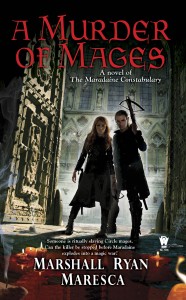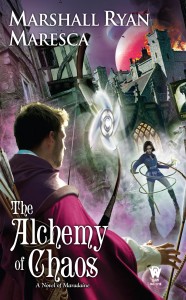In my Twelve Part Outline Structure, the final part is "resolution", in which the plot elements are, you know, resolved in a satisfying way. That usually involves some form of your heroes managing to check another mark in the win column, or at least pull off some form of tie/stalemate.*
But then, once the day is is saved-- or at least immediate danger quelled-- there's got to be some wind down. How much is too much, that's the question.
 My instinct is to at least have some sort of check-in with the key plot points or character threads. If it's a story with strong POV rules (for example, in A Murder of Mages we only get POVs from Minox and Satrine), then it's a good idea to have than final reflection or check-in with those POVs.
My instinct is to at least have some sort of check-in with the key plot points or character threads. If it's a story with strong POV rules (for example, in A Murder of Mages we only get POVs from Minox and Satrine), then it's a good idea to have than final reflection or check-in with those POVs.
The big rule for me is making sure nothing is left ambiguous that shouldn't be ambiguous. For example, if a minor character was hurt in the big finale, you should make it clear that either A. they're going to be all right or B. they aren't, and what the consequences might be.
Rowling liked to have a pattern for her denouement in the Harry Potter books-- or at least the first five-- which was essentially Dumbledore Explains It All For You. After everything is done, one way or another Harry has a sit-down with Dumbledore in which the old wizard lays out what the heck actually happened and clarifies any plot holes there might have been. After that, it's more or less Harry packs up and takes the train home.
 My various series don't have quite the same structure-- and in the Thorn books, Prof. Alimen doesn't quite fulfill the same role-- though in both Thorn of Dentonhill and The Alchemy of Chaos, a good portion of the denouement is centered around a Veranix/Alimen scene. I'll confess, the denouement for The Imposters of Aventil was extremely challenging. That book, frankly, has a lot of balls in the air, so making sure each of those balls doesn't drop on the floor before the book is done was crucial-- especially doing it in such a way that it didn't feel like I was just dragging my heels to get to the end. That said, I won't give anything away, save this: the denouement does not maintain the pattern.
My various series don't have quite the same structure-- and in the Thorn books, Prof. Alimen doesn't quite fulfill the same role-- though in both Thorn of Dentonhill and The Alchemy of Chaos, a good portion of the denouement is centered around a Veranix/Alimen scene. I'll confess, the denouement for The Imposters of Aventil was extremely challenging. That book, frankly, has a lot of balls in the air, so making sure each of those balls doesn't drop on the floor before the book is done was crucial-- especially doing it in such a way that it didn't feel like I was just dragging my heels to get to the end. That said, I won't give anything away, save this: the denouement does not maintain the pattern.
And that's fine. We need to mix things up to keep the work fresh.
Speaking of, this draft won't write itself. Off to the word mines.
---
*- It depends on the type of story, but sometimes "not losing" is as much of a victory as your heroes are going to get.
